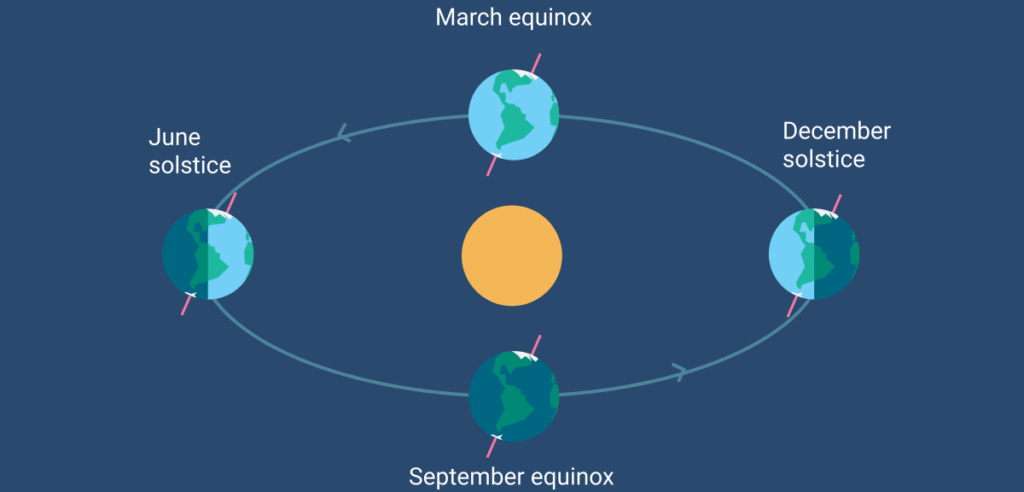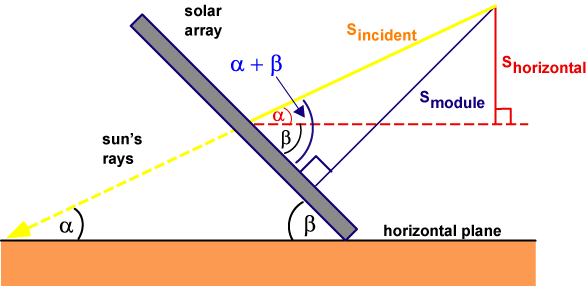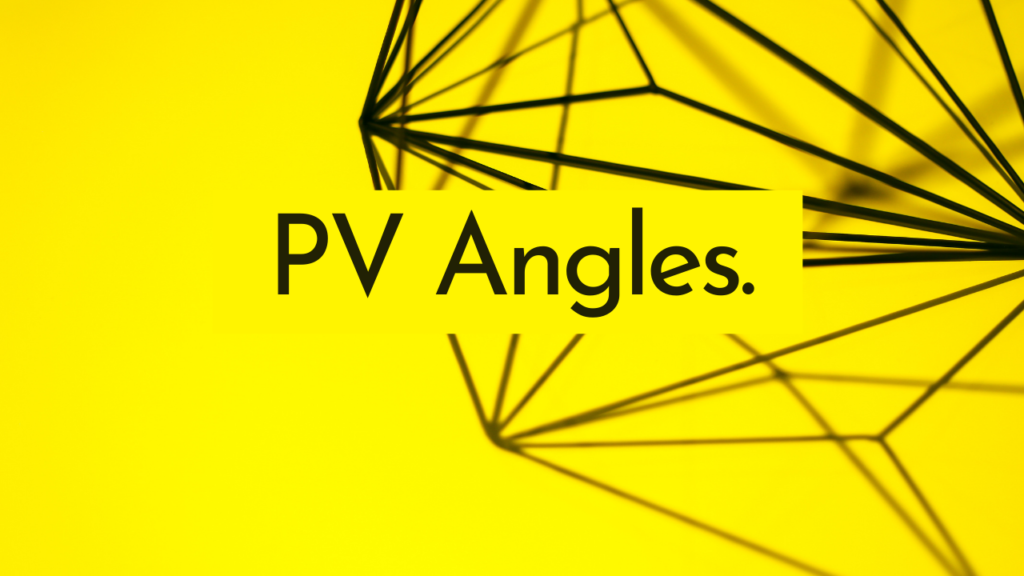Declination Angle (δ)
The angle between the equator and a line drawn from the centre of the Earth to the centre of the sun through Solar Radiation. This varies due to the tilt of the earth as it revolves around the sun. At the March and September equinoxes, the angle of declination is at 0o, The summer and winter solistice will have a maximum (23.5o) and minimum (-23.5o) respectively.

This is quite important since the design is usually done based on the point with the weakest solar radiation (Winter Solistice). The declination angle can be found by the equation below (In excel, you want to make sure that the value inside the bracket remains as radians and not degrees so multiply by π/180)

Eqn 1

Eqn 2

Tilt Angle (β)
The angle between the solar panel and the ground (horizontal plane). This angle has to be optimised to ensure that solar radiation is perpendicular to the surface of the panel. The formula for optimal tilt angle is shown below

Eqn 3
Azimuth Angle
The horizontal orientation of your panels (in relation to your equator). You should point your panels toward true south as opposed to the reading on your compass, which is magnetic south if your site location lies in the Nothern Hemisphere, if not then true North.
A photovoltaic system, also PV system or solar power system, is a power system designed to supply usable solar power by means of photovoltaics. It consists of an arrangement of several components, including solar panels to absorb and convert sunlight into electricity, a solar inverter to convert the output from direct to alternating current, as well as mounting, cabling, and other electrical accessories to set up a working system.
It may also use a solar tracking system to improve the system’s overall performance and include an integrated battery solution, as prices for storage devices are expected to decline. Strictly speaking, a solar array only encompasses the ensemble of solar panels, the visible part of the PV system, and does not include all the other hardware, often summarized as balance of system (BOS). As PV systems convert light directly into electricity, they are not to be confused with other solar technologies, such as concentrated solar power or solar thermal, used for heating and cooling.
PV systems range from small, rooftop-mounted or building-integrated systems with capacities from a few to several tens of kilowatts, to large utility-scale power stations of hundreds of megawatts. Nowadays, most PV systems are grid-connected, while off-grid or stand-alone systems account for a small portion of the market.
Operating silently and without any moving parts or environmental emissions, PV systems have developed from being niche market applications into a mature technology used for mainstream electricity generation. A rooftop system recoups the invested energy for its manufacturing and installation within 0.7 to 2 years and produces about 95 percent of net clean renewable energy over a 30-year service lifetime.[1]:30[2][3]
Due to the growth of photovoltaics, prices for PV systems have rapidly declined since their introduction. However, they vary by market and the size of the system. In 2014, prices for residential 5-kilowatt systems in the
United States were around $3.29 per watt,[4] while in the highly penetrated German market, prices for rooftop systems of up to 100 kW declined to €1.24 per watt.[5] Nowadays, solar PV modules account for less than half of the system’s overall cost,[6] leaving the rest to the remaining BOS-components and to soft costs, which include customer acquisition, permitting, inspection and interconnection, installation labor and financing costs.[7]:14
A photovoltaic system, also PV system or solar power system, is a power system designed to supply usable solar power by means of photovoltaics. It consists of an arrangement of several components, including solar panels to absorb and convert sunlight into electricity, a solar inverter to convert the output from direct to alternating current, as well as mounting, cabling, and other electrical accessories to set up a working system.
It may also use a solar tracking system to improve the system’s overall performance and include an integrated battery solution, as prices for storage devices are expected to decline. Strictly speaking, a solar array only encompasses the ensemble of solar panels, the visible part of the PV system, and does not include all the other hardware, often summarized as balance of system (BOS). As PV systems convert light directly into electricity, they are not to be confused with other solar technologies, such as concentrated solar power or solar thermal, used for heating and cooling.
PV systems range from small, rooftop-mounted or building-integrated systems with capacities from a few to several tens of kilowatts, to large utility-scale power stations of hundreds of megawatts. Nowadays, most PV systems are grid-connected, while off-grid or stand-alone systems account for a small portion of the market.
Operating silently and without any moving parts or environmental emissions, PV systems have developed from being niche market applications into a mature technology used for mainstream electricity generation. A rooftop system recoups the invested energy for its manufacturing and installation within 0.7 to 2 years and produces about 95 percent of net clean renewable energy over a 30-year service lifetime.[1]:30[2][3]
Due to the growth of photovoltaics, prices for PV systems have rapidly declined since their introduction. However, they vary by market and the size of the system. In 2014, prices for residential 5-kilowatt systems in the
United States were around $3.29 per watt,[4] while in the highly penetrated German market, prices for rooftop systems of up to 100 kW declined to €1.24 per watt.[5] Nowadays, solar PV modules account for less than half of the system’s overall cost,[6] leaving the rest to the remaining BOS-components and to soft costs, which include customer acquisition, permitting, inspection and interconnection, installation labor and financing costs.[7]:14
A photovoltaic system, also PV system or solar power system, is a power system designed to supply usable solar power by means of photovoltaics. It consists of an arrangement of several components, including solar panels to absorb and convert sunlight into electricity, a solar inverter to convert the output from direct to alternating current, as well as mounting, cabling, and other electrical accessories to set up a working system.
It may also use a solar tracking system to improve the system’s overall performance and include an integrated battery solution, as prices for storage devices are expected to decline. Strictly speaking, a solar array only encompasses the ensemble of solar panels, the visible part of the PV system, and does not include all the other hardware, often summarized as balance of system (BOS). As PV systems convert light directly into electricity, they are not to be confused with other solar technologies, such as concentrated solar power or solar thermal, used for heating and cooling.
PV systems range from small, rooftop-mounted or building-integrated systems with capacities from a few to several tens of kilowatts, to large utility-scale power stations of hundreds of megawatts. Nowadays, most PV systems are grid-connected, while off-grid or stand-alone systems account for a small portion of the market.
Operating silently and without any moving parts or environmental emissions, PV systems have developed from being niche market applications into a mature technology used for mainstream electricity generation. A rooftop system recoups the invested energy for its manufacturing and installation within 0.7 to 2 years and produces about 95 percent of net clean renewable energy over a 30-year service lifetime.[1]:30[2][3]
Due to the growth of photovoltaics, prices for PV systems have rapidly declined since their introduction. However, they vary by market and the size of the system. In 2014, prices for residential 5-kilowatt systems in the
United States were around $3.29 per watt,[4] while in the highly penetrated German market, prices for rooftop systems of up to 100 kW declined to €1.24 per watt.[5] Nowadays, solar PV modules account for less than half of the system’s overall cost,[6] leaving the rest to the remaining BOS-components and to soft costs, which include customer acquisition, permitting, inspection and interconnection, installation labor and financing costs.[7]:14
A photovoltaic system, also PV system or solar power system, is a power system designed to supply usable solar power by means of photovoltaics. It consists of an arrangement of several components, including solar panels to absorb and convert sunlight into electricity, a solar inverter to convert the output from direct to alternating current, as well as mounting, cabling, and other electrical accessories to set up a working system.
It may also use a solar tracking system to improve the system’s overall performance and include an integrated battery solution, as prices for storage devices are expected to decline. Strictly speaking, a solar array only encompasses the ensemble of solar panels, the visible part of the PV system, and does not include all the other hardware, often summarized as balance of system (BOS). As PV systems convert light directly into electricity, they are not to be confused with other solar technologies, such as concentrated solar power or solar thermal, used for heating and cooling.
PV systems range from small, rooftop-mounted or building-integrated systems with capacities from a few to several tens of kilowatts, to large utility-scale power stations of hundreds of megawatts. Nowadays, most PV systems are grid-connected, while off-grid or stand-alone systems account for a small portion of the market.
Operating silently and without any moving parts or environmental emissions, PV systems have developed from being niche market applications into a mature technology used for mainstream electricity generation. A rooftop system recoups the invested energy for its manufacturing and installation within 0.7 to 2 years and produces about 95 percent of net clean renewable energy over a 30-year service lifetime.[1]:30[2][3]
Due to the growth of photovoltaics, prices for PV systems have rapidly declined since their introduction. However, they vary by market and the size of the system. In 2014, prices for residential 5-kilowatt systems in the
United States were around $3.29 per watt,[4] while in the highly penetrated German market, prices for rooftop systems of up to 100 kW declined to €1.24 per watt.[5] Nowadays, solar PV modules account for less than half of the system’s overall cost,[6] leaving the rest to the remaining BOS-components and to soft costs, which include customer acquisition, permitting, inspection and interconnection, installation labor and financing costs.[7]:14
A photovoltaic system, also PV system or solar power system, is a power system designed to supply usable solar power by means of photovoltaics. It consists of an arrangement of several components, including solar panels to absorb and convert sunlight into electricity, a solar inverter to convert the output from direct to alternating current, as well as mounting, cabling, and other electrical accessories to set up a working system.
It may also use a solar tracking system to improve the system’s overall performance and include an integrated battery solution, as prices for storage devices are expected to decline. Strictly speaking, a solar array only encompasses the ensemble of solar panels, the visible part of the PV system, and does not include all the other hardware, often summarized as balance of system (BOS). As PV systems convert light directly into electricity, they are not to be confused with other solar technologies, such as concentrated solar power or solar thermal, used for heating and cooling.
PV systems range from small, rooftop-mounted or building-integrated systems with capacities from a few to several tens of kilowatts, to large utility-scale power stations of hundreds of megawatts. Nowadays, most PV systems are grid-connected, while off-grid or stand-alone systems account for a small portion of the market.
Operating silently and without any moving parts or environmental emissions, PV systems have developed from being niche market applications into a mature technology used for mainstream electricity generation. A rooftop system recoups the invested energy for its manufacturing and installation within 0.7 to 2 years and produces about 95 percent of net clean renewable energy over a 30-year service lifetime.[1]:30[2][3]
Due to the growth of photovoltaics, prices for PV systems have rapidly declined since their introduction. However, they vary by market and the size of the system. In 2014, prices for residential 5-kilowatt systems in the
United States were around $3.29 per watt,[4] while in the highly penetrated German market, prices for rooftop systems of up to 100 kW declined to €1.24 per watt.[5] Nowadays, solar PV modules account for less than half of the system’s overall cost,[6] leaving the rest to the remaining BOS-components and to soft costs, which include customer acquisition, permitting, inspection and interconnection, installation labor and financing costs.[7]:14
A photovoltaic system, also PV system or solar power system, is a power system designed to supply usable solar power by means of photovoltaics. It consists of an arrangement of several components, including solar panels to absorb and convert sunlight into electricity, a solar inverter to convert the output from direct to alternating current, as well as mounting, cabling, and other electrical accessories to set up a working system.
It may also use a solar tracking system to improve the system’s overall performance and include an integrated battery solution, as prices for storage devices are expected to decline. Strictly speaking, a solar array only encompasses the ensemble of solar panels, the visible part of the PV system, and does not include all the other hardware, often summarized as balance of system (BOS). As PV systems convert light directly into electricity, they are not to be confused with other solar technologies, such as concentrated solar power or solar thermal, used for heating and cooling.
PV systems range from small, rooftop-mounted or building-integrated systems with capacities from a few to several tens of kilowatts, to large utility-scale power stations of hundreds of megawatts. Nowadays, most PV systems are grid-connected, while off-grid or stand-alone systems account for a small portion of the market.
Operating silently and without any moving parts or environmental emissions, PV systems have developed from being niche market applications into a mature technology used for mainstream electricity generation. A rooftop system recoups the invested energy for its manufacturing and installation within 0.7 to 2 years and produces about 95 percent of net clean renewable energy over a 30-year service lifetime.[1]:30[2][3]
Due to the growth of photovoltaics, prices for PV systems have rapidly declined since their introduction. However, they vary by market and the size of the system. In 2014, prices for residential 5-kilowatt systems in the
United States were around $3.29 per watt,[4] while in the highly penetrated German market, prices for rooftop systems of up to 100 kW declined to €1.24 per watt.[5] Nowadays, solar PV modules account for less than half of the system’s overall cost,[6] leaving the rest to the remaining BOS-components and to soft costs, which include customer acquisition, permitting, inspection and interconnection, installation labor and financing costs.[7]:14
